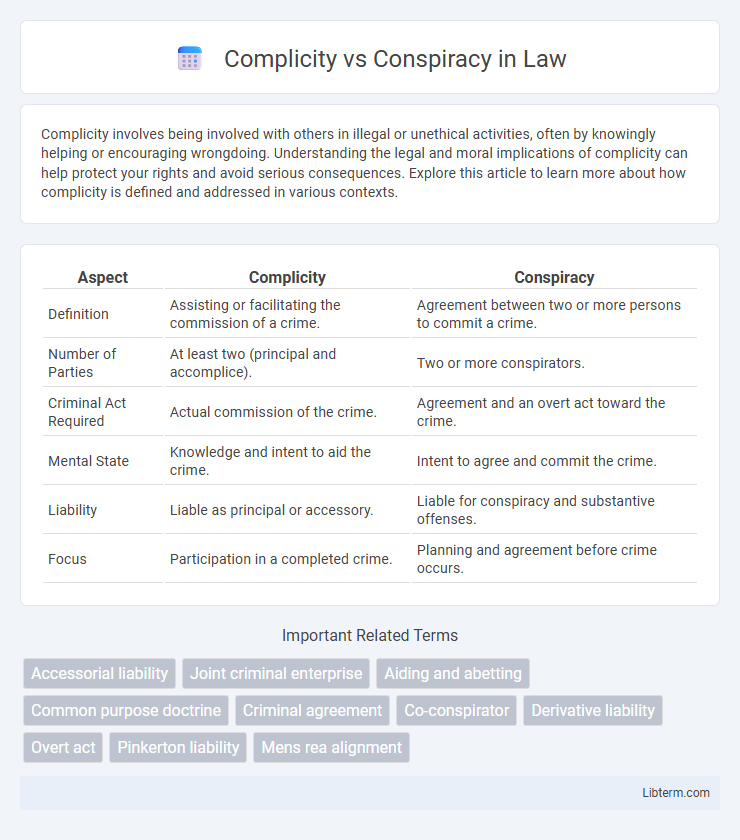Complicity involves being involved with others in illegal or unethical activities, often by knowingly helping or encouraging wrongdoing. Understanding the legal and moral implications of complicity can help protect your rights and avoid serious consequences. Explore this article to learn more about how complicity is defined and addressed in various contexts.
Table of Comparison
| Aspect | Complicity | Conspiracy |
|---|---|---|
| Definition | Assisting or facilitating the commission of a crime. | Agreement between two or more persons to commit a crime. |
| Number of Parties | At least two (principal and accomplice). | Two or more conspirators. |
| Criminal Act Required | Actual commission of the crime. | Agreement and an overt act toward the crime. |
| Mental State | Knowledge and intent to aid the crime. | Intent to agree and commit the crime. |
| Liability | Liable as principal or accessory. | Liable for conspiracy and substantive offenses. |
| Focus | Participation in a completed crime. | Planning and agreement before crime occurs. |
Understanding Complicity: Definition and Key Elements
Complicity involves knowingly assisting or facilitating the commission of a crime without directly engaging in the criminal act, requiring the presence of intent and participation. Key elements include awareness of the criminal activity, intentional aid or encouragement, and a proximate relationship to the primary offender's conduct. Understanding these components is essential for distinguishing complicity from conspiracy, which centers on an agreement to commit a crime rather than actual participation.
What Constitutes Conspiracy: Legal Overview
Conspiracy constitutes an agreement between two or more persons to commit a criminal act, requiring proof of the agreement and an overt act towards its execution. Unlike complicity, which involves aiding or abetting a crime, conspiracy centers on the collaborative intent and planning before the crime occurs. Legal statutes emphasize the necessity of a clear mutual understanding and steps taken to advance the criminal objective for a conspiracy charge to be upheld.
Core Differences Between Complicity and Conspiracy
Complicity involves assisting or facilitating the commission of a crime by another person, where the accomplice plays a secondary role without necessarily planning the offense. Conspiracy requires an agreement between two or more parties to commit a criminal act, emphasizing the mutual understanding and intent to commit the crime. The core difference lies in complicity being a reactive participation, while conspiracy is proactive collaboration before the crime occurs.
The Role of Intent in Complicity vs Conspiracy
The role of intent in complicity versus conspiracy distinguishes the two legal concepts by the specificity and timing of the defendant's mental state. In conspiracy, intent requires an agreement between two or more parties to commit an unlawful act, showing a mutual goal held at the formation of the conspiracy. Complicity involves intent to assist or facilitate the principal offender's criminal act, emphasizing purposeful participation rather than agreement on the plan itself.
Legal Consequences: Penalties for Complicity and Conspiracy
Penalties for complicity often involve sentencing that corresponds to the primary crime, including imprisonment, fines, or probation, depending on the severity and jurisdiction. Conspiracy charges typically carry distinct penalties that may include statutory sentences specified for agreeing to commit a crime, which can be as severe as those for the attempted or completed offense. Legal consequences for both complicity and conspiracy vary widely but consistently emphasize deterrence through incarceration and financial penalties.
Typical Scenarios: Real-Life Examples of Each
Complicity often arises in scenarios where individuals knowingly assist or facilitate a crime, such as a getaway driver aiding a bank robbery or an employee covering up fraudulent activities within a company. Conspiracy involves an agreement between two or more parties to commit an illegal act, exemplified by co-conspirators planning a cyberattack or orchestrating a drug trafficking operation. Both complicity and conspiracy carry distinct legal implications and require evidence of intent and participation in the criminal activity.
Proving Complicity vs Proving Conspiracy in Court
Proving complicity requires demonstrating that the defendant intentionally assisted or facilitated the commission of a crime, often through acts or encouragement that directly contributed to the offense. Proving conspiracy involves establishing an agreement between two or more parties to commit an unlawful act and an overt act taken in furtherance of that agreement. Courts rely heavily on evidence such as communications, witness testimony, and actions that show intent and coordination to differentiate between complicity and conspiracy in legal proceedings.
Defenses Against Complicity and Conspiracy Charges
Defenses against complicity and conspiracy charges often include lack of intent, proving absence of knowledge or participation, and demonstrating withdrawal from the criminal agreement before the offense occurs. Establishing duress or coercion can also negate culpability by showing that the defendant acted under threat. Effective legal strategy requires detailed examination of communication and conduct to challenge the prosecution's proof of agreement or assistance in the crime.
Notable Case Studies: Complicity and Conspiracy in Practice
In the landmark case of *Enron Corporation*, key executives faced conspiracy charges for orchestrating widespread fraud, demonstrating how coordinated efforts to deceive investors constitute conspiracy. Conversely, the *Amber Heard and Johnny Depp* defamation trial highlighted complicity, where individuals allegedly assisted or facilitated the principal actions without formal agreement to commit a crime, illustrating the subtler nuances of legal responsibility. These cases underscore the distinct legal thresholds for proving conspiracy, which requires an agreement and intent, versus complicity, often proven through participation or assistance in the criminal act.
Impact on Justice: Why Distinguishing Matters
Distinguishing complicity from conspiracy is crucial for assigning appropriate legal responsibility and ensuring fair justice outcomes. Complicity involves aiding or encouraging a crime, while conspiracy requires an agreement to commit a crime, impacting the severity of charges and penalties. Accurate differentiation upholds the integrity of judicial decisions and protects defendants from wrongful convictions or excessive sentencing.
Complicity Infographic

 libterm.com
libterm.com